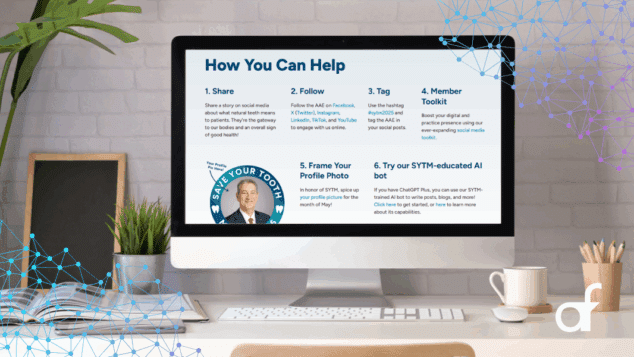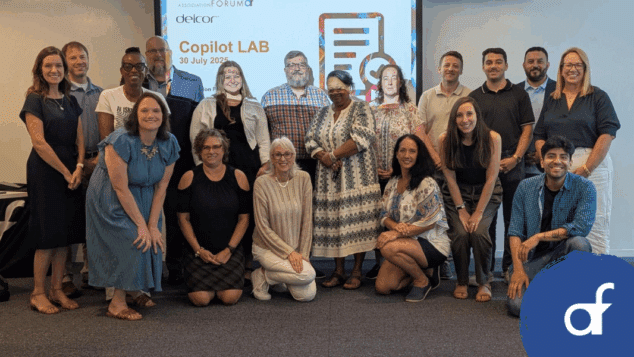The All-Important App

Attendees go to conferences not just for the opportunity to learn or earn continuing education (CE), but for the connections and experiences. Technology is playing a critical role in facilitating these experiences. Conference and event apps have been widespread for several years, but as technology evolves, so do the capabilities and opportunities available through conference apps.
A conference app serves as an important hub that can provide essential information, such as the conference agenda, speaker bios, session locations and registration, presentation resources, shuttle schedules, and exhibit floor plans. Beyond the basics, apps can provide a variety of ways for attendees to engage—whether it be through networking features, such as viewing others who have registered for a session, sharing photos, or gamification elements, like rewarding attendees with points and prizes for taking certain actions in the app.
If you’re considering implementing a conference app for the first time, there are definite benefits, but also a learning curve. Knowing what to expect for a first-time event app implementation and anticipating some of the challenges can help ensure a successful launch. If you’re experienced with the technology but looking to up your app game, there’s always something new to consider, with the digital landscape changing so quickly.
Here’s the download on conference apps and some guidelines to follow to ensure your event app gets five stars.
12 Tips for Event App Success
Be aware of the app landscape.
If you’re thinking about introducing an event app at your next meeting, you might not know where to begin. Unless your organization has a robust, in-house IT department that has experience with programming and building apps, chances are your organization will look to a third-party to help with app development.
There are hundreds of companies that offer event app-building services of varying degrees. EventMB publishes an annual Event App Bible that gives a comprehensive overview of more than 100 event app companies; a useful guide for all meeting planners.
Although there are enough options to make your head spin, one trend that is being seen throughout the industry is consolidation, with many event app companies merging or acquiring one another. Consolidation can lead to stronger event app capabilities and potential for more synergy with other tools in the marketing technology stack, but it also means less choice for meeting planners—or that your beloved app tool could change or be discontinued in the future.
Look for comprehensive app features.
Event apps can be built with basic or advanced features, but a few core attributes will serve your attendees best.
Marie Simmons is a technology and mobile strategy consultant at Meeting Expectations, an association management company that also specializes in meeting and event management for nonprofit and for-profit clients. Simmons confirms that the agenda and interactive maps are top features. “It can become a maze on the exhibit floor, and the interactive map can show you exactly where you are,” she says.
Networking features are also growing in popularity. “Attendees can reach out and schedule one-on-one meetings with others at the event,” Simmons says, adding that attendees can set their profiles to private if they don’t want to be contacted.
Rating features, such as attendee polls and surveys, not only keep attendees engaged, but also provide valuable data to conference planners. Offering these tools through the app can help with participation rates. “Attendees often don’t have the time or patience to complete session or post-event surveys on paper or through email,” Simmons explains. “With the app, you can send a poll or survey notification and make it easy for people to complete it on their phone.”
Not to mention, last-minute changes or day-of communications are a snap with the app. “In the real-world, things change, people don’t show up, sessions might go over or breakfast might be moved,” Simmons says. “When a change like that happens, conference planners have to scramble to let everyone know. But with the app, push notifications can be a lifesaver to let attendees know about changes or just to remind them where to go.”
Lara Deloza, director of brand content and communications at the International Literacy Association (ILA), says her organization has used an app for its annual conference for a few years. “It’s been a great tool for attendees to build their schedules and we’re able to update room and speaker changes on the fly, plus use push notifications for alerts,” Deloza says.
Plan ahead.
Meeting Expectations’ technology team, including Simmons, builds custom conference and event apps for a variety of clients and at a range of price points. Typically, Simmons says, a uniquely branded event app can be launched within four or five months.
Apps can be built and launched through a container app—which is essentially a house for one or more event apps—or as a standalone app. Container apps can be entirely custom-branded for the organization, or they can be app-vendor branded, and the organization’s app lives within the vendor container.
Organizations that wish to build their own container or a standalone app are looking at a longer timeline. Building your own container or standalone app requires setting up a Developer account with the Apple App Store, which can take weeks, and the Google Play Store, which can take a few days. There is also a review and approval process, which takes some time—anywhere from a few hours to a few days.
The upside to this approach, although more time-intensive and costly, is that the app is a completely branded experience for attendees.
However, the technical requirements should not be overlooked. “There are more hoops to jump through with a fully branded app,” Simmons says. “There’s the cost for the developer license and the time for approval.”
Get several quotes.
The event app world can be a bit opaque at times, especially when it comes to price. Many event app companies do not publish their fees publicly. EventMB’s Event App Bible secured quotes from app providers for an event with 100 attendees, and prices ranged on the low end at $1,900 to nearly $10,000; the median price was $4,500.
With prices ranging so drastically, costs can escalate quickly. You’ll want to spend time determining exactly what you want your event app to achieve so that you can be clear about your requirements and expectations when pricing out your options. And, if your event draws a smaller crowd, one of the free event app solutions might work for you.
Consider the potential cost savings.
Event apps are an investment, and if executed correctly, they can bring about some savings, especially if it allows your organization to reduce costs elsewhere. For example, some event apps also offer registration and check-in features, which can save you costs if you are paying for these capabilities through separate tools.
And, of course, with an event app, there is the potential to reduce or minimize printed materials. Deloza says ILA hasn’t entirely replaced its printed program, but it has allowed the program to become slimmer. “We’ve been able to cut our printed program pages in half,” she says.
Simmons agrees that it’s important to look at the full picture: “It usually takes one or two years before an organization feels ready to reduce or eliminate the onsite guide, but once they look at the budget, it makes sense.”
Take advantage of sponsorship opportunities.
Sponsorship and advertising opportunities can not only defray the costs of an event app, they can also produce a new revenue stream. Simmons says she has seen many associations successfully take advantage of mobile app sponsorship opportunities. “You can add opportunities to the sponsorship prospectus, such as offering a splash screen or banner in the app,” she explains.
Deloza agrees, and ILA has been able to enhance its sponsorship offerings through the event app. “Exhibitors like the app directory, which shows their booth numbers and location,” she explains. “We’ve been able to sell ads and sponsored push notifications to help defray some of the costs.”
If you’re planning to rely on sponsorship and ad dollars, make sure that the event app you select has the capabilities to support these features.
Benchmark your success.
When launching your app for the first time, be prepared for lower adoption rates. But with each following year, you can expect to see the percentage of attendees who download your app rise.
Simmons says the first year an organization offers an event app, a 30–35% adoption rate is not unusual because attendees are still getting used to the app. “There is typically some resistance the first year,” she says. After the first year, a 65–75% adoption rate is a good benchmark to strive for.
Deloza says ILA’s annual conference draws about 5,000 attendees and about half of all attendees downloaded and used the app. ILA also used an app during a smaller meeting of fewer than 600 attendees, and it was a hit. “More than two-thirds of attendees not only downloaded the app but created profiles and used it.”

Conference organizers must identify what features they’re looking for when designing an event app. For example, having an exhibitor floor plan and directory readily available can greatly improve the event experience for attendees.
Promote and demo the app.
Sufficiently marketing and promoting your event app is key to driving high adoption rates. Be sure to prominently feature the app on all conference marketing materials. Also, provide a demo or tutorial so that attendees can learn how to make the most of the app’s features.
ILA provided an online guide for how to download and use the app, as well as an in-person demo, which likely contributed to the high adoption rate. “There was a learning curve the first couple years,” Deloza recounts. “But now, we debate whether or not to even hold the demo since few people show up for it.”
Provide free Wi-Fi.
To make the app experience as seamless as possible, provide free Wi-Fi during your event. Deloza said the first year ILA offered the event app, Wi-Fi was not offered at the conference because the contract had already been negotiated years in advance. As you might expect, attendees were frustrated and Deloza says the lack of Wi-Fi was “problematic.”
Review the data.
An important and useful aspect of event and conference apps are the analytics. After the event, review the app data to gather meaningful insights. There are basic analytics, such as number of downloads and overall traffic, but conference planners can also look at more nuanced usage patterns, such as which speakers or sessions get the most traffic or bookmarks, providing guidance for future planning. Some apps will even integrate with Google Analytics for more robust reporting. The amount of data you can glean from your event app will vary depending on the app’s capabilities, so keep your reporting needs in mind when selecting and developing your app.
Be realistic.
Like with all technology, expect some bumps in the road. Even with the slickest apps, there may be some tools that don’t work as expected or have low participation rates. Deloza has experienced this firsthand: She is still working on gaining more traction in the networking feature and has struggled with some of the reporting features. ILA attendees can rate sessions, but “it’s not a feature that’s used as heavily as I’d like,” Deloza notes.
Keep an eye on emerging technologies.
If your organization has offered an event app for many years, consider integrating emerging technologies to keep attendees engaged. The most advanced event apps are offering tools like recommendations for nearby places and events of interest, chatbots, indoor navigation and augmented reality features.
With 2019 Holiday Showcase around the corner, download the Forum Events app on iOS or Android today.
Tags
Related Articles
Turning AI Into Member Value
How AAE’s Save Your Tooth Month GPT became a personalized marketing assistant for members
The Power of Taking the AI Journey Together
Forum’s first Microsoft Copilot Lab brought together 20 professionals to explore how smart adoption of...
Protecting Healthcare: Tackling Cyber Threats to Hospitals and Patients
The critical role of cybersecurity in healthcare and association management.




